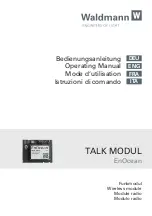
Glossary
SCALANCE W786-xPRO
246
Operating Instructions, Release 08/2007, C79000-G8976-C221-02
System
All the electrical equipment within a system. A system includes, among other things:
Programmable logic controllers, devices for operator control and monitoring, bus systems,
field devices, drives, power supply cabling.
TCP/IP
TCP = Transport Connection Protocol; IP = Internet Protocol
TKIP
Temporal Key Integrity Protocol. Scheme for cyclic changing of keys in WLANs.
TPC
The Transmit-Power Control function (TPC) introduced as a supplementary function by the
802.11h enhancement for 5 GHz components allows an automatic adaptation of the transmit
power. Information on the attenuation values and the expected budget reserves in received
power are taken into account. TPC is also intended to make sure that the maximum
permitted transmit power of a channel specified by the relevant regulatory bodies is not
exceeded by the component. TPC attempts to operate with the minimum transmit power
between the communicating stations or between access point and station.
WBM
Web Based Management. HTTP-based configuration method in which an HTTP server is
used in the relevant device.
WDS
Wireless Distribution System. Radio links for connecting the access points for an extended
service set (ESS)
WEP
Wired Eqivalence Privacy is an optional part of the IEEE 802.11 standard. WEP specifies
methods of authentication and encryption working with fixed keys stored on the device. All
devices that want to access a network in which WEP is used must first be supplied with the
same keys. The keys can also only be renewed manually.
Wi-Fi
Wireless Fidelity. Specification for wireless networks.
The Wi-Fi Alliance is a group of WLAN manufacturers that tests and certifies the
interoperability of WLAN products. Wi-Fi is a certification of WLANs according to 802.11b
and is performed by WECA, the WiFi parent organization. This certification confirms the
interoperability of WLAN products operating in compliance to the 802.11b standard.
The Wi-Fi Alliance also develops standards. The WiFi Alliance has developed its own
architectures for security procedures that have not yet been standardized such as the WiFi





































